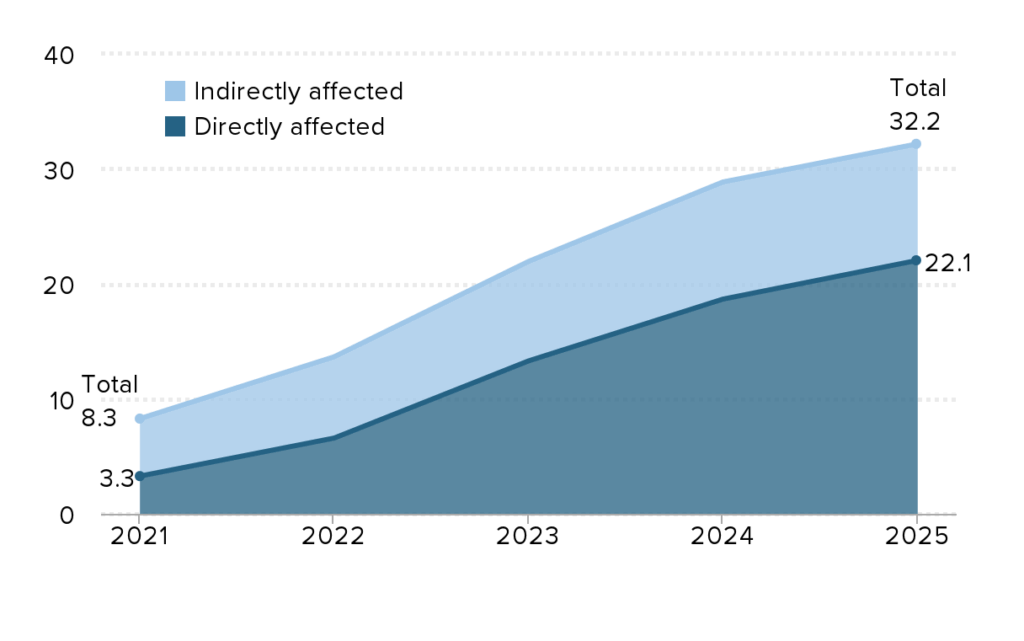After years of political gridlock, the effort to raise the federal minimum wage to $15 an hour is getting new life in Washington. A bipartisan proposal, introduced in May by Senators Josh Hawley (R-Mo.) and Peter Welch (D-Vt.), would phase in the increase by 2026 and automatically tie future hikes to inflation. The move is a response to what lawmakers call a “wage freeze” that has left the federal minimum at $7.25 since 2009.

But while Congress debates, the patchwork of state-level action reveals a divided wage landscape—with 21 states and Washington, D.C. on track to hit or exceed $15, and 20 states still stuck at the federal floor.
The Push for a $15 Minimum Wage Is Back
| Insight | What It Reveals |
|---|---|
| 21 states + D.C. will reach $15 by 2027 | These include CA, IL, MA and others |
| 20 states stuck at $7.25 | Mostly in the South and Midwest—AL, TX, WI, and more . |
| D.C., WA, CA already exceed $15 | DC is $17.50, WA $16.66, CA $16.50 . |
| Raising to $15 helps millions | EPI notes ~32 M workers would benefit, with annual raises of ~$3,300. |
The federal minimum wage may have stood still since 2009, but America hasn’t. As inflation rises and inequality grows, the debate over $15 is no longer theoretical. With a new bipartisan bill in Congress and state-level action surging, 2026 could be the year that finally brings change.
Where States Stand on $15 Minimum Wage
The minimum wage debate is no longer just a national issue—it’s a state-by-state race. Some states are racing ahead, while others refuse to budge.
- Already There:
Washington, D.C. leads the nation at $17.50 per hour, followed closely by Washington state ($16.66) and California ($16.50). Several cities like San Francisco and Seattle already exceed $18 due to local laws. - On the Way:
States like Massachusetts, Connecticut, Illinois, and New Jersey have laws phasing in $15 over the next few years. - Lagging Behind:
A total of 20 states—including Texas, Alabama, Mississippi, and Georgia—have not adopted a higher wage and still default to the federal minimum of $7.25.
“It’s been 16 years since the federal minimum wage was last raised,” Sen. Hawley said during the bill’s announcement. “Working Americans have seen their wages flatline while the cost of living has skyrocketed.”
Who Benefits—and Who Doesn’t
According to the Economic Policy Institute (EPI), raising the minimum wage to $15 could boost pay for 32 million workers, or about one-fifth of the U.S. workforce. The biggest beneficiaries? Women and workers of color.
- 31% of Black workers and 26% of Hispanic workers would see a raise.
- Workers would earn an average of $3,300 more per year.
States that have already made the shift report early benefits. In California, where a $20/hour fast-food minimum wage went into effect this year, workers say they’re better able to afford rent and groceries. “That bump helped me catch up on bills I was always behind on,” said Rosa Mendoza, a cashier in San Jose.

Why Some States Still Resist
Despite strong public support—62% of Americans back a $15 federal minimum wage, according to Pew Research—many state governments have dug in their heels.
Several states have preemption laws that block cities from setting their own higher wages. Texas, for instance, bans local wage ordinances. Budget concerns are also at play: counties like Harris in Texas have delayed implementation over cost.
Political will varies. In some conservative states, even local ballot initiatives have been blocked or overturned by legislatures.
The Bipartisan Plan: What’s Inside
The new proposal—the Higher Wages for American Workers Act—would:
- Raise the federal minimum to $15/hour by 2026
- Index it to inflation, avoiding another 16-year freeze
- Phase in increases differently based on cost-of-living per state
The bill’s bipartisan backing could give it legs. Welch, a Democrat, called it “long overdue,” while Hawley emphasized its populist appeal to working-class voters.
Still, some progressive groups worry the gradual rollout gives too much leeway to business lobbyists. Others see it as a pragmatic path forward.
What’s Next?
The Senate bill is expected to face committee hearings this summer, but even if it passes the Senate, it may hit turbulence in the House. That said, momentum is building. As more states cross the $15 threshold, pressure on Congress continues to grow.
Meanwhile, advocates urge workers to check local ordinances—especially in states with tiered systems. “You may be eligible for more than you think,” said Rebecca Dixon of the National Employment Law Project.






